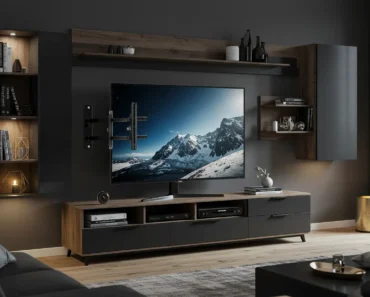Refinishing Engineered Hardwood Floors: A Comprehensive Guide. This guide offers essential insights and practical steps for homeowners looking to restore the beauty of their engineered hardwood, ensuring a successful and rewarding renovation project.
Why Consider Refinishing Engineered Hardwood Floors?
Engineered hardwood floors offer the timeless beauty of solid wood with added stability. Over time, however, daily wear and tear can diminish their luster. Scratches, scuffs, and faded areas appear, making floors look tired. Instead of replacing the entire floor, refinishing presents a cost-effective and sustainable solution. It breathes new life into your existing investment.
Many homeowners wonder if refinishing engineered hardwood floors is even possible. The answer depends on the thickness of the floor’s top layer, known as the wear layer. This critical layer, made of real wood, allows for sanding and re-coating. A thicker wear layer permits more refinishes. This versatility makes engineered hardwood a popular choice.
Restoring your floors through refinishing enhances your home’s aesthetic appeal. It also protects your investment. A freshly refinished floor instantly brightens a room. It adds value to your property. It renews the protective coating, safeguarding the wood from future damage. This process offers significant benefits beyond just appearance.
Key Considerations for Refinishing Engineered Hardwood Floors
Before embarking on any refinishing project, careful assessment of your existing engineered hardwood floors is essential. This initial evaluation dictates the feasibility and approach.
Wear Layer Thickness: The Deciding Factor
The most critical factor when considering Refinishing Engineered Hardwood Floors is the thickness of the wear layer. This is the top layer of real wood that sits above the plywood or high-density fiberboard core.
Typically:
A wear layer of 2mm or less usually does not allow for full sanding. Light buffing and re-coating might be possible.
A wear layer of 3mm or more generally permits one or two full sandings.
A wear layer of 5mm or more can handle multiple refinishes, similar to solid hardwood.
You can find this information from your flooring installer or manufacturer specifications. If unsure, a flooring professional can assess your specific floor.
Type of Finish: Matching or Changing
Understand your current floor’s finish. Is it polyurethane, aluminum oxide, or an oil-based finish? This impacts the refinishing process and product compatibility. Polyurethane and oil-based finishes are typically easier to sand and re-coat. Aluminum oxide, a very durable factory finish, often requires specialized sanding equipment or a professional to remove it effectively.
Consider whether you want to maintain the existing finish type or switch to a new one. This decision influences product selection and preparation steps.
Damage Assessment: Beyond Surface Scratches
Inspect your floors for damage beyond surface scratches. Deep gouges, water damage, swelling, or extensive warping might indicate that refinishing is not sufficient. These issues often require board replacement before any refinishing can occur. Significant structural damage limits refinishing possibilities.
A professional assessment helps determine if your engineered hardwood is a good candidate for refinishing. They can advise on repairs needed before the process begins.
Steps for Refinishing Engineered Hardwood Floors
Refinishing engineered hardwood floors involves several distinct phases. Each step requires meticulous attention to detail for a smooth, durable, and beautiful outcome.
1. Preparation: Setting the Stage for Success
Thorough preparation is non-negotiable. First, remove all furniture, rugs, and décor from the room. Clean the floor meticulously. Use a vacuum cleaner to remove all dust and debris, then mop with a hardwood floor cleaner designed to remove grime without leaving residue. Ensure the floor is completely dry before proceeding. Any lingering dirt or moisture compromises the refinishing process. This critical initial step prevents contaminants from embedding in the new finish.
2. Repairs: Addressing Imperfections
Address any minor repairs before sanding. Fill small holes or gouges with wood putty that matches your floor’s color. Allow the putty to dry completely, then sand smooth. For deeper scratches that penetrate the wear layer, consult a professional. They might suggest a patch or specialized filler. Repairing imperfections now ensures a uniform surface for the new finish. It improves the final aesthetic outcome.
3. Sanding: Removing the Old Finish
Sanding removes the old finish and levels minor imperfections. For engineered hardwood, this step requires extreme caution due to the thin wear layer. Use a **drum sander** or **orbital sander** with fine-grit sandpaper (100-120 grit). Start with the highest grit possible to remove the finish. Avoid aggressive sanding that might wear through the veneer. Sand in the direction of the wood grain. This prevents cross-grain scratches. For edges and corners, use an edge sander or detail sander. Collect all dust meticulously with a powerful vacuum. This thorough dust removal is critical for a clean finish application.
4. Cleaning After Sanding: The Dust-Free Zone
After sanding, meticulous cleaning is paramount. Fine dust particles can compromise the new finish. Vacuum the entire area multiple times, paying close attention to corners and edges. Use a damp cloth or tack cloth to wipe down all surfaces, including walls, baseboards, and windowsills, to remove airborne dust. Allow surfaces to dry completely before applying any new products. A truly dust-free environment ensures a smooth, flawless finish.
5. Staining (Optional): Changing the Color
If you desire a color change, apply a wood stain after sanding and cleaning. Choose a stain color that complements your home’s décor. Apply it evenly with a rag or brush, working in small sections. Wipe off excess stain according to product instructions. Allow the stain to dry completely, which can take 24-48 hours depending on humidity and product type. Always test the stain on an inconspicuous area first. This step provides a new aesthetic foundation.
6. Applying the Finish: The Protective Layer
Apply a new protective finish. Water-based polyurethane is a popular choice for its fast drying time and low odor. Oil-based polyurethane offers strong durability and a richer amber tone over time, but it takes longer to dry. Apply thin, even coats using a roller or brush, working in the direction of the wood grain. Allow each coat to dry completely before applying the next, typically 2-4 hours for water-based and 24 hours for oil-based. Lightly buff between coats with fine-grit sandpaper (220 grit) for better adhesion and a smoother finish. This creates a durable, beautiful surface.
7. Curing Time: Patience for Durability
The finish needs adequate time to cure, not just dry. While floors might feel dry to the touch in hours, the full curing process takes days or even weeks. Foot traffic can usually resume after 24-48 hours (light traffic only). Wait at least 72 hours before replacing furniture. Avoid placing rugs for at least two weeks to allow for proper air circulation and full curing. Premature use damages the finish. This patience ensures maximum durability and longevity for your newly refinished engineered hardwood floors.
Also Read: How To Clean Prefinished Hardwood Floors
Choosing the Right Professional for Refinishing Engineered Hardwood Floors
While do-it-yourself refinishing is possible for experienced homeowners, hiring a specialized professional often proves the wiser choice, especially for engineered hardwood. Their expertise minimizes risks and ensures a superior result.
When to Hire a Professional
Consider hiring a professional for Refinishing Engineered Hardwood Floors if:
Your floor has a thin wear layer (2-3mm). Professionals have the specialized equipment and delicate touch required to avoid sanding through the veneer.
Your floor has an aluminum oxide finish. This finish is difficult to remove and requires specific abrasive tools.
You have extensive damage that requires board replacement or complex repairs.
You lack experience with power sanders or have concerns about achieving an even finish.
The area is large, intricate, or involves multiple rooms.
A professional’s expertise provides peace of mind and often a better outcome.
Qualities of a Good Flooring Professional
When selecting a professional for Refinishing Engineered Hardwood Floors, look for these qualities:
Experience with engineered hardwood: Ensure they specifically understand the nuances of refinishing engineered floors, not just solid wood.
Licensing and insurance: Verify they are properly licensed and insured for your protection.
References and portfolio: Request references from previous clients and review their portfolio of finished work.
Clear communication: Choose a professional who communicates clearly about the process, timeline, and costs.
Detailed quote: Obtain a written, itemized quote that outlines all services, materials, and expected timelines.
Dust containment: Inquire about their dust containment systems. Modern professionals use advanced equipment to minimize dust.
A reputable professional ensures a smooth, high-quality refinishing experience.
Budgeting for Refinishing Engineered Hardwood Floors
The cost of Refinishing Engineered Hardwood Floors varies significantly based on factors like labor, materials, and the extent of work. Understanding these components helps you budget realistically.
Do-It-Yourself Costs (Lower End)
If you choose to refinish your engineered hardwood floors yourself, your costs primarily involve equipment rental and materials.
Sander rental (drum, orbital, edge): $75-$150 per day
Sandpaper: $50-$100
Wood putty/repair materials: $20-$50
Stain (optional): $30-$80
Finish (polyurethane): $50-$150 per gallon (multiple gallons needed)
Cleaning supplies: $20-$50
Total DIY costs can range from $200-$500 for a small to medium-sized room, excluding your time and potential mistakes. This option saves labor costs.
Professional Costs (Higher End)
Hiring a professional for Refinishing Engineered Hardwood Floors involves labor, materials, and overhead.
Cost per square foot: Typically ranges from $3.00 to $7.00 per square foot for a full sand and refinish.
Factors affecting cost:
Floor condition: More repairs or difficult existing finishes increase costs.
Wear layer thickness: Very thin wear layers requiring delicate work might be more expensive.
Dust containment systems: High-quality, dustless systems add to the cost but provide a cleaner process.
Staining vs. just re-coating: Staining adds labor and material costs.
Location: Costs vary by region.
For a 500 sq ft room, professional refinishing might cost $1,500 – $3,500. This investment covers expertise, specialized equipment, and guaranteed results.
Consider Additional Costs
Factor in potential additional costs:
Temporary housing: If you cannot stay in your home during refinishing due to fumes or curing times.
Moving and storing furniture: Professional movers or temporary storage solutions.
Baseboard removal/replacement: If necessary for a clean finish.
Contingency fund: Always set aside 10-20% of your budget for unforeseen issues.
Planning for these additional expenses ensures a smooth renovation experience.
Caring for Your Refinished Engineered Hardwood Floors
Proper care and ongoing maintenance extend the life and beauty of your newly refinished engineered hardwood floors. Consistent habits protect your investment.
Regular Cleaning and Maintenance
After the curing period, establish a regular cleaning routine. Vacuum or sweep daily with a soft-bristle broom to remove dirt and grit. These tiny particles can act like sandpaper. Mop weekly with a damp (not wet) microfiber mop and a pH-neutral hardwood floor cleaner. Avoid steam mops, harsh chemicals, or oil-based cleaners, which damage the finish. Promptly wipe up spills. This prevents water damage and stains.
Preventive Measures
Place felt pads under all furniture legs to prevent scratches. Use doormats at all entry points to trap dirt and moisture. Avoid walking on floors with high heels or abrasive footwear. Keep pets’ nails trimmed. Protect floors from direct sunlight with curtains or blinds, as UV rays cause fading. These preventive steps significantly extend the life of your finish.
Re-Coating (Screen and Re-coat)
For ongoing maintenance, consider a “screen and re-coat” every few years, depending on traffic. This process involves lightly abrading the existing finish (screening) and applying a fresh coat of polyurethane without full sanding. This maintains the protective layer. It postpones the need for another full refinish, especially beneficial for engineered hardwood with thin wear layers.
Latest Innovations in Refinishing Engineered Hardwood Floors
The flooring industry continually innovates, bringing new products and techniques that enhance durability, ease of application, and environmental friendliness. These advancements improve the process of Refinishing Engineered Hardwood Floors.
Low-VOC and Water-Based Finishes
New formulations of finishes, especially water-based polyurethanes, offer significantly lower Volatile Organic Compounds (VOCs). This means fewer harmful fumes during application and curing. They dry faster, allowing quicker re-entry into your home. These finishes also provide excellent durability. This makes them a healthier and more convenient option for homeowners and professionals.
This innovation reduces environmental impact. It improves indoor air quality.
Advanced Dust Containment Systems
Modern professional refinishing increasingly uses advanced dust containment systems. These powerful vacuums attach directly to sanding equipment. They capture nearly all dust generated during the sanding process. This results in a virtually dust-free renovation, greatly reducing cleanup and airborne irritants.
These systems benefit both homeowners and contractors. They create a healthier work environment. They ensure a cleaner finish application.
UV-Cured Finishes (Professional Only)
Some professional refinishing services now offer UV-cured finishes. These finishes cure instantly under ultraviolet light, allowing furniture and traffic to resume immediately after application. This eliminates extended curing times and disruption. They offer exceptional durability.
This innovation provides a rapid return-to-use solution. It is ideal for commercial spaces or homeowners needing minimal downtime.
Making Your Final Decision on Refinishing Engineered Hardwood Floors
Refinishing Engineered Hardwood Floors is a significant project that yields beautiful results. Your decision requires careful consideration of your floor’s condition, your skills, and your budget.
Prioritize assessing your wear layer thickness. This determines whether a full sand and refinish is feasible or if a screen and re-coat is the better option. Do not risk damaging your floors by trying to sand too deeply.
Consider your comfort level with DIY projects. If you lack experience with large sanders or precise finish application, hiring a professional minimizes risk and ensures a superior outcome. Their expertise often justifies the cost.
Do not overlook the importance of proper preparation and curing time. These steps are critical for the longevity and beauty of your refinished floors. Patience during this period pays dividends.
Remember, a beautifully refinished engineered hardwood floor enhances your home’s appeal and value. When you approach this project thoughtfully, you transform your space and enjoy its renewed beauty for years to come.
Restore Your Floors: The Power of Refinishing Engineered Hardwood Floors
Refinishing Engineered Hardwood Floors offers a smart and effective way to rejuvenate your home’s beauty and protect your investment. This process breathes new life into tired surfaces, transforming rooms with renewed elegance.
Take time to understand your floor’s specific needs. Choose the right approach, whether a DIY project or professional service. Remember that meticulous preparation and proper curing are key to a lasting finish.
As you embark on this rewarding project, remain patient and detail-oriented. Your efforts will culminate in stunning floors that enhance your living space for years.
By applying these insights and taking the necessary steps, you unlock the full potential of your engineered hardwood. Prepare to enjoy the renewed beauty and extended lifespan of your magnificent floors.
Frequently Asked Questions About Refinishing Engineered Hardwood Floors
Can all engineered hardwood floors be refinished?
Not all engineered hardwood floors can be refinished. The ability to refinish depends on the thickness of the top real wood layer, called the wear layer. Floors with a wear layer of 3mm or more are generally suitable for one or more sandings.
How do I know the wear layer thickness of my engineered hardwood?
You can often find the wear layer thickness from your original flooring installer or the manufacturer’s specifications. If you do not have this information, a flooring professional can often assess it by looking at a cross-section of a sample or by carefully inspecting an inconspicuous area.
What is the difference between refinishing and “screen and re-coat”?
Refinishing engineered hardwood floors involves full sanding to remove the old finish and a thin layer of wood, then applying new stain and finish. “Screen and re-coat” is a lighter process that only buffs the top layer of the existing finish before applying a new coat, without removing any wood. It is suitable for floors with minor wear.
How long does it take for a refinished engineered hardwood floor to cure?
While the floor might be dry to the touch in hours, the full curing process for the finish typically takes 2-4 weeks. Light foot traffic can resume after 24-48 hours. Avoid placing rugs or heavy furniture for at least 72 hours, and preferably longer, to allow for proper curing.
Can I refinish engineered hardwood floors myself, or should I hire a professional?
You can refinish engineered hardwood floors yourself if you have experience with power sanders and understand the wear layer limitations. However, many homeowners hire professionals to ensure proper sanding depth, even finish application, and effective dust containment, especially if the wear layer is thin or the existing finish is aluminum oxide.




